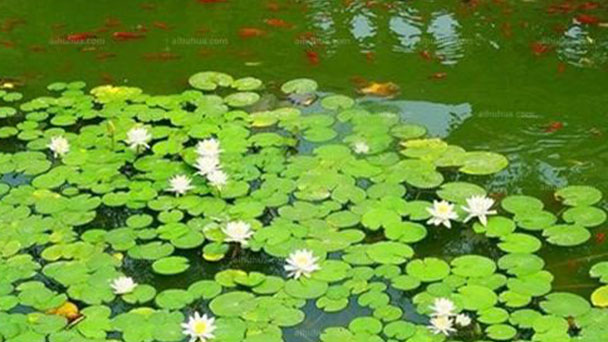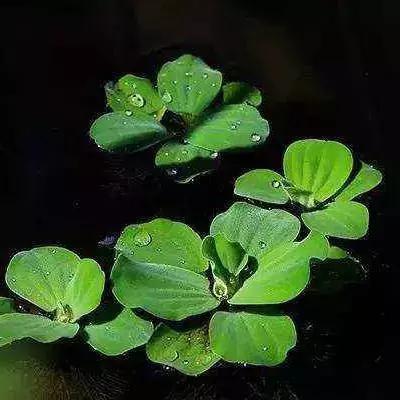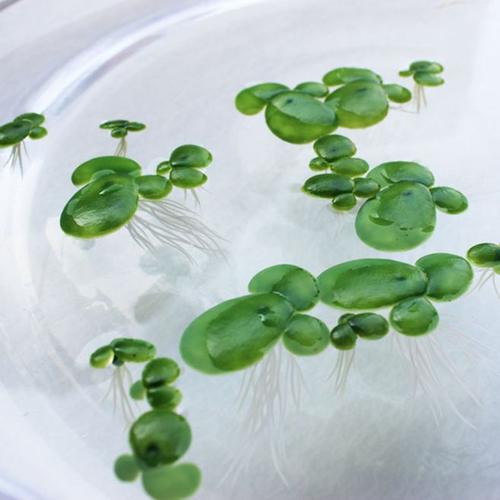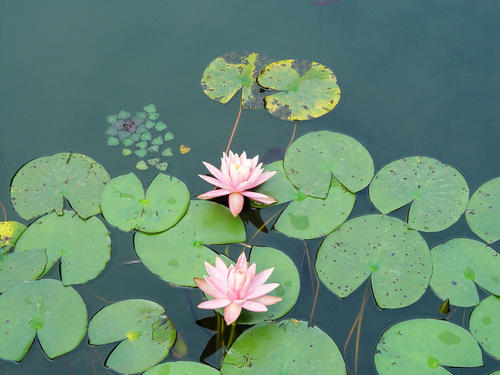Common Duckweed profile
Written by Maggie
Dec 22 2020

Lemna minor, the common duckweed or lesser duckweed, is a species of aquatic freshwater plant in the subfamily Lemnoideae of the arum family Araceae. L. minor is used as animal fodder, bioremediator, for wastewater nutrient recovery, and other applications.
Common Duckweed is widespread in warm parts of the world, but not in Java, Indonesia. In all the provinces of North and south China, floating communities are formed in paddy fields, ponds and other still water areas. They are often mixed with purple duckweed to form floating communities densely covered with water, which usually dominate the community.
Common Duckweed is for good pig feed, duck feed; It is also a bait for grass carp. When used as medicine, it can sweat, benefit water, reduce swelling and poison, treat rheumatism, beriberi, heat and erysipelas, bleeding, edema, inability to urinate, inability to penetrate the macula, cold and fever without sweating.
Common Duckweed picture

Common Duckweed morphological characteristics
The Common Duckweed is a floating plant. On the back surface of the thallus is symmetrical, green, white or light yellow or green is often purple, suborbicular, obovoid or ovoid elliptic, margin entire, 1.5 5 mm long, 2 -- 3 mm wide, slightly raised above or along the central uplift, veins 3, not obvious, hanging on the back with a filamentous root, root, white 3-4 cm long, root cap blunt, root sheath wingless.
There is a sac on the dorsal side of the Common Duckweed. New lobules emerge from the sacs and are attached to the mother with a very short stalk. Female flowers with curved ovules 1, fruit wingless, sub gyro - shaped, seeds with protruding endosperm with 12-15 longitudinal ribs.
Common Duckweed Native habitat
Common Duckweed is widespread in warm parts of the world, but not in Java, Indonesia. It is distributed all over the north and south of China. Duckweed likes warm climates and a humid environment, and avoids cold. Paddy fields, ponds and lakes should be selected for cultivation. Growing in paddy fields, ponds or other still waters, often mixed with Spirodela Polyrrhiza (L.) Schleid.), forming floating communities densely covered with water, which usually dominate in the community due to the rapid breeding of the species.
Common Duckweed cultivation techniques
The Common Duckweed floats or floats on the water. The leaves are soft, and the Common Duckweed is better eaten by 6cm to 10cm seedlings of grass carp.The Common Duckweed is intolerant of high temperatures and tends to die and turn white in late summer.
The pond to choose
The pond where Common Duckweed is cultivated should be sheltered from the wind, in a still water environment, with convenient transportation, surrounded by stones, with steps going up and down, covering an area of 2.5-3.5mu, with a bottom 20-25cm thick silt and a depth of 1.0-1.5m, and with the ability to keep water and fertilizer. It is forbidden to raise ducks and geese. The pond should not be too large, the area is difficult to avoid wind, still water; The leaky pond and the cultivation pond of Chinese fir (black algae) are not suitable for the cultivation of duckweed (The growth advantage of Chinese fir is faster than duckweed). North facing south house in front of the fence around the pond is best.

The pond management
Mixed planting management of Wolffia Globosa, Common Duckweed and Spirodela Polyrrhiza:
From April to early May, when the Wolffia Globosa has a certain density and covers the whole pond surface, every morning or evening, 10-15 meters of straight bamboo is used to stop the turnips from going up and down the steps, and a pure amount of Wolffia Globosa is collected with a 60-eye hand-cutting net to be used for the early consumption of red meat (summer flowers) of grass carp, so as to produce grass carp seedlings with robust body length and neat specifications.As grass carp grow towards seedling, the yield of Wolffia Globosa is insufficient, so an appropriate amount of Common Duckweed species is added to the Wolffia Globosa pond to increase the yield.But Spirodela Polyrrhiza could not be added, and the grass carp could not eat the shoots.At this time, a moderate amount of the majority of the Common Duckweed and a small amount of Wolffia Globosa should be collected with a 40-mesh hand-cutting net for the grass carp to eat towards the seedlings.From the middle of June to the late of July, grass carp seedlings grow into inch seedlings. In hot weather, Wolffia Globosa reproduction slows down, and Common Duckweed is not resistant to high temperature. In late summer, the high temperature will cause sunburn, whiten and rot.The growth of turpentine turpentine and Common Duckweed is limited. An appropriate amount of Spirodela Polyrrhiza species is added to the ponds of Wolffia Globosa and Common Duckweed to increase the yield. At this time, the growth advantage of Spirodela Polyrrhiza is obvious, and Wolffia Globosa is fine.The large-sized Spirodela Polyrrhiza gives shade to the Wolffia Globosa and the Common Duckweed, but the appropriate amount of the Spirodela Polyrrhiza and a small amount of Wolffia Globosa and the Common Duckweed should be obtained with the 20-mesh hand-making net to feed the grass carp.Wolffia Globosa, Common Duckweed, Spirodela Polyrrhiza pond in summer, when the temperature is high, the pond Duckweed species can't catch too much. When the wind is strong, the pond Duckweed species are divided into small pieces to prevent the white and sky from revealing, producing a large number of rotifers, followed by the outbreak of cyanobacteria water.In the later period, Spirodela Polyrrhiza, Common Duckweed and Wolffia Globosa ponds were applied with 0.35kg trichlorfon in a regular mu to prevent parasites and germs from laying eggs or sticky bacteria in the roots of Common Duckweed and Wolffia Globosa.When the water quality deteriorates, there are snails and wild fish. After soaking in tea cake for 24 hours, bring water to the toxic pond and stop fishing for fish species for three days.Early only Wolffia globosa pond every 15 days turn to float on the surface of the water as a basal snakeskin bag, tied every 30 days after open the bag, bag slag in the water or the shore, the same with snakeskin bag chicken, pig dung fertilizer, mu shi 50 kg, and tighten the bag mouth float on the surface or sink to the bottom for fertilizer fertilizer water quality, late have Wolffia globosa, Common Duckweed, Spirodela polyrrhiza pond fertilizer, mu shi 75 kilograms, interval of 20 days, ten days turn again and keep water clean,Apply fertilizer frequently and lightly.From mid-October to early March of the next year, when the weather turns cool, the yields of Spirodela Polyrrhiza, Wolffia Globosa and Common Duckweed decrease. Add 6000-8000 7 juvenile dace (winter) seedlings, 500 20 cm large grass carp species, and an appropriate amount of silver carp and bighead seedlings to the pond. Eat the Common Duckweed, Spirodela Polyrrhiza and Wolffia Globosa, commonly known as pink-pond farming.But to use bamboo to the turnip, duckweed, purple back duckweed spacing side, to prevent oxygen deprivation, floating head fish.Pond access to raise winter fish species management.In the second year, the fish species were released, caught and marketed in spring. In the middle and late March, Wolffia Globosa was cultivated in ponds and entered the production cycle of the New Year according to the above operation.

Common Duckweed main value
Feed: Common Duckweed is good pig feed and duck feed; Common Duckweed is a high-quality green fodder for grass carp species, and grass carp fed with Common Duckweed are less likely to suffer from hepatobiliary syndrome.
Medicinal use: Common Duckweed can induce sweating, rehydration, and reduce swelling and poison, treat rheumatism, beriberi, heat and erysipelas, bleeding, edema, inability to urinate, inability to penetrate the macula, cold and fever without sweating.
Latest Updated
- Benefits of Bugleweed - 7 Science-backed Health Benefits
- Bugleweed Dangers & Side Effects - Is It Poisonous?
- How to Plant Evergreen Trees - What You Should Know
- When to Plant Evergreens - Grow Guide for Evergreen Trees
- 12 Wonderful Evergreen Shrubs for Your Garden
- 12 Popular Evergreen Plants with Pictures for Beginners
- When And How To Prune A Lilac Bush Like a Pro
- How to Grow & Care for Lilac Vine (Hardenbergia Violacea)
- Japanese Lilac Tree (Syringa Reticulata) Care & Propagation Guide
- Shumard Oak Pros and Cons - What to Know
Popular Articles
- Winter maintenance of Antirrhinum Majus
- How to Grow Terminalia Mantaly Tree
- How to Grow and Care for Crossostephium Chinense
- How to grow Antirrhinum Majus in spring
- Peristeria Elata (Dove Orchid) Profile: Info & Care Guide
- Underwatered Snake Plant (Sansevieria Trifasciata) - Signs And How To Fix
- How to Care for Brazilian Jasmine Plant (Mandevilla Sanderi)
- How to Grow & Care for Graptopetalum Purple Delight in Summer
- Rosa Chinensis (China Rose): Plant Growing & Care Tips
- How to Care for Baby Sun Rose (Aptenia Cordifolia)